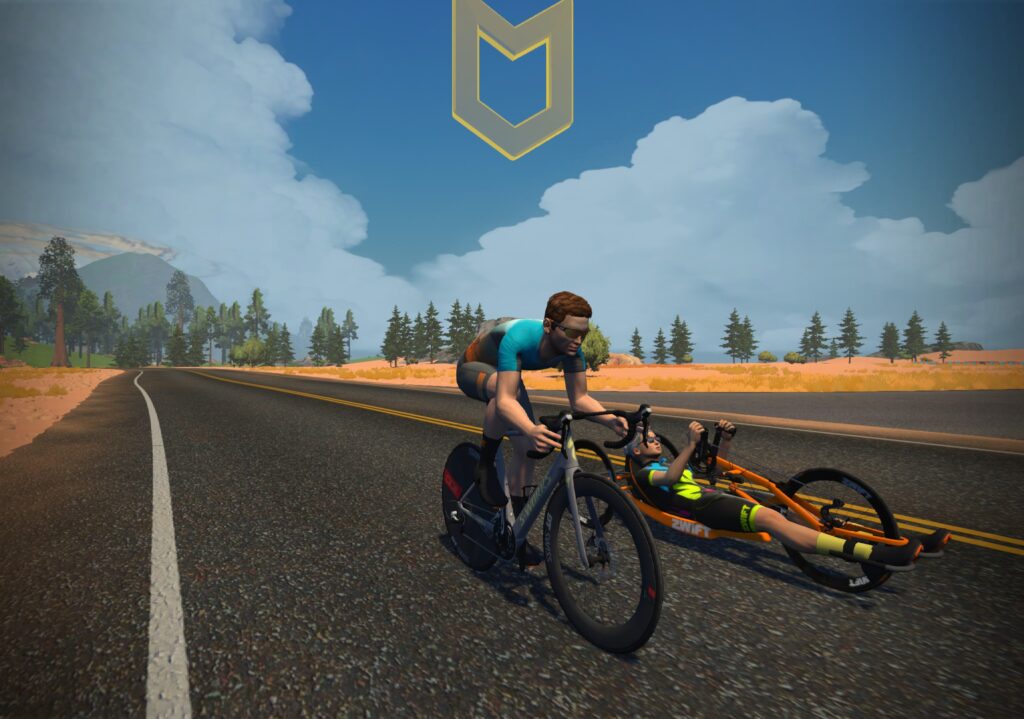Astute Zwifters know the game calculates your virtual bike speed using a combination of “personal” factors (wattage, weight, and height) as well as external factors (bike frame and wheelset choice plus the virtual environment including road surfaces, gradient, etc).
Here at Zwift Insider we’ve already thoroughly tested how height affects speed on Zwift road bikes. But what about Zwift’s newer handcycle? Does Zwift calculate rider CdA differently due to your avatar’s reclined position on the handcycle? Just what sort of performance difference does rider height have for handcycle riders?
Let’s dig in and find out…
Speed Test Data
This chart shows the time it took riders of varying heights to complete our standard flat test course (2 laps of Tempus Fugit) at different power levels. Each rider was set at 75kg weight and used the same virtual bike setup (Zwift’s handcycle) – the only variables across the tests were rider height and wattage.
Height vs Speed at Various Power Levels
Conclusions
- As we found with our road bike tests, Zwift’s physics hold remarkably steady across a wide range of rider sizes (153cm to 193cm, or approximately 5′ to 6’4″).
- Zwift’s physics also hold remarkably steady across a wide range of wattages (150-450W).
- As power increases, speeds increase. As speeds increase, the time gaps between riders of varying heights are reduced.
- For example, at 150W, the difference between a 153cm and 193cm rider is 201 seconds. At 450W, those riders are only separated by 142 seconds.
- While the gaps in seconds may change across power levels, in terms of percentage of overall time, these gaps hold pretty steady, with overall time increasing by 5.32% (at 150W) to 5.7% (at 450W) when rider height changes from 153cm to 193cm.
- Why does the percentage difference increase at higher wattages? Because aerodynamics matter more at higher speeds.
- At lower heights, adding a centimeter makes a bigger difference. Going from 173cm to 193cm slows you by approximately 2.47%, but going from 153cm to 173cm slows you by approximately 2.78%. This makes sense, because as you get taller each centimeter is a smaller percentage of your overall height.
- Another way to look at the chart is that it shows how many watts each centimeter of added height costs.
- For example, we can see that 153cm at ~163W delivers the same time as 173cm at ~182W. So we know that a rider will need to hold ~9W higher to match a rider 10cm shorter. Or looking at it another way, every centimeter costs ~1 watt.
- At higher wattages this cost is even higher, with a 10cm jump costing closer to ~25W in the 450W range (so ~2.5 watts per centimeter). This is because being more aero matters more at higher speeds.
So how much difference does a centimeter make? Here are estimated numbers based on the chart above:
- At 150W, every added centimeter
- Adds ~5.03 seconds
- Costs 0.8 watts
- At 300W, every added centimeter
- Adds ~3.98 seconds
- Costs ~1.38 watts
- At 450W, every added centimeter
- Adds ~3.55 seconds
- Costs ~1.5 watts
I Wish I Were Smaller
We’ve already discussed height doping a bit in our original height speed tests, so we won’t rehash it here.
Should Height Matter So Much On Handcycles?
Our guess is, Zwift didn’t change the rider portion of their physics calculation when it comes to the handcycle. So while the handcycle itself performs a bit differently than road bikes, rider height and weight changes will have the same speed effects on handcycles as they do on road bikes.
The question is: does this make sense?

Given the reclining position of a handcycle rider, it would seem that height should affect speed here even less than on a road bike. But in the end, for better or for worse, Zwift appears to have taken a very simple approach to calculating rider CdA for the handcycle.
Questions or Comments?
Share below!

